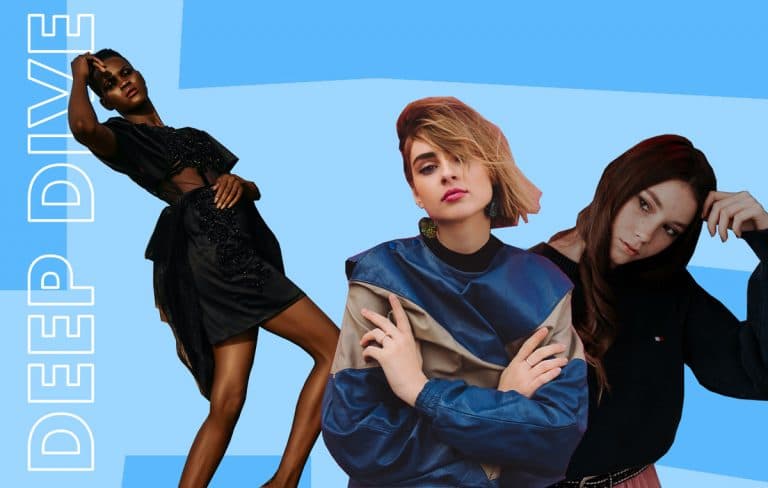Surviving the pandemic: How brands turned to their own employees to model campaigns

Since the exasperating repercussions that we all faced in 2020 (and 2021 too) due to the COVID-19 global pandemic have become clearer, more and more brands have been forced to seek refuge in-house for unusual model casting. Brands have turned to their own employees to model for their campaigns. Which brands exactly, and how could this new approach change the way the modelling industry runs the fashion market?
Acne Studios casted employees as models for its Fall 2020 season campaign
One fashion house, Acne Studios, which was founded in 1996 in Stockholm and has been growing its market ever since, has taken the in-house initiative onboard by launching its Fall 2020 season campaign with its own employees as the face of the collection.
The new season’s campaign was photographed by Anders Edström at the brand’s headquarters in Stockholm and features dog illustrations from British artist Lydia Blakeley, with most of the creative work being done in quarantine. This collection revolves around suits and not just Blakeley’s illustrations but real-life dogs too. Starring the company’s global wholesale director Pontus Björkman (and his Yorkshire Terrier, Kenzo) as well as Acne Studios’ global communications director Edouard Schneider (alongside a Miniature Dachshund called Pumba) and technical designer Iona Ciocan (and her trusty Bulldog, Jasper).
Although this is not an entirely new concept to the fashion industry—J.Crew, among very few others, has actually done it for years and Comptoir des Cotonniers has built a reputation around its mother and daughter theme, where models are in fact real mothers and daughters. The French brand has also previously launched competitions for mothers and daughters to enter together. However, for other luxury brands, this way of scouting models hasn’t been all that common—until now.
Gucci’s own designers were the models for its latest collection
Among the rare high fashion brands to bring the core of their companies to the surface was Gucci. For its 2021 Gucci Cruise campaign, which was originally scheduled to debut in May in San Francisco but then cancelled due to travel restrictions and safety regulations, creative director Alessandro Michele rethought the entire traditional fashion calendar.
The designer decided he would not only downsize his production to two shows, but to everyone’s surprise, he kicked off a 12-hour livestream showcase called ‘Epilogue’ which teased the Cruise 2021 collection as well as a behind the scenes look at the campaign’s photoshoot from the Palazzo Sacchetti in Rome. Viewers that tuned in had a full view of everything from hair and makeup to models and photographers figuring out each shot.
For the collection’s lookbook, Michele brought in his own team to model the designs. This included Gucci’s casting assistant, its fabric researcher, embroidery designers, beauty product developers, accessory designers, ready-to-wear designers and many more. Michele announced in an official statement that “The clothes will be worn by those who created them. The designers with whom, every day, I share the daze of creation, will become the performers of a new story. They will seize the poetry they contributed to mould. They will stage what we passionately imagined. It’s a process of role reversal, once more.”
Burberry staff model the brand's lookbook outside their own homes in England
A little over a month after releasing its Fall 2020 line, Burberry is yet another luxury fashion house that is adapting to the times with fluidity. In creating its 2021 Spring Summer pre-collection lookbook, Riccardo Tisci, Burberry’s chief creative officer moved away from the Irina Shayks and Kendall Jenners of the world, and moved towards his own Burberry colleagues and collaborators to showcase the brand’s latest achievements.
Tisci officially stated that he is “so proud of this collection which not only reflects and celebrates the unique codes that make the house, but also the diversity of talent that represents our Burberry community, bringing the magic of the Burberry world to life.”
Among this eclectic cast were members of the fashion house’s retail team, finance team, merchandising team, design team, copy team, and the list goes on. Each of these newly proclaimed models were photographed outside of their homes in England. The chief creative officer said that he “called upon the incredible talent at Burberry to open their doors and be a part of this journey—each interpreting the looks in their own unique way outside in the landscapes of London and beyond.” One employee’s cat even made the cut.
Burberry stayed true to the brand’s heritage by keeping the brand’s signature prints, emblems and silhouettes consistent, but updated them with “elements of both sophistication and street through the lens of the outdoors,” Tisci commented. He continued by saying that “this season, I wanted to draw upon the familiar, the things that bring us comfort and strength,” which is exactly what we needed in the uncertain times of 2020. That being said, will these luxury giants continue to seek inspiration from valuable assets such as these? And more so, will this change become commonplace within the modelling industry when we finally pass the hems of the global pandemic?
It evidently seems as though COVID-19 is pushing the fashion industry as well as general consumerism into an entirely new era. Consumers are starting to appear as though they crave and increasingly demand authenticity and diversity from advertising, clothing and make-up industries. May we say, it’s about time? Let’s see what 2021 has to offer.




